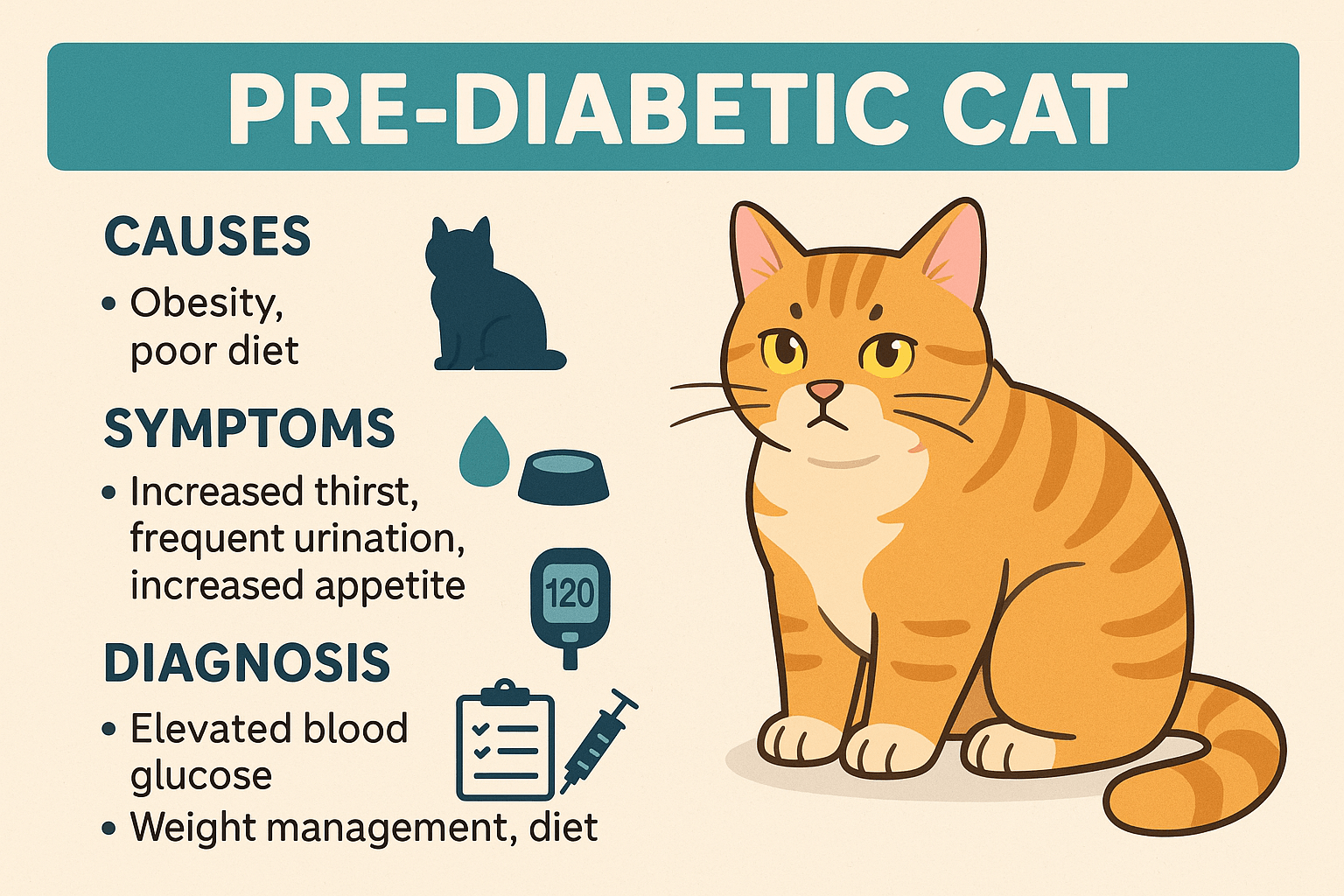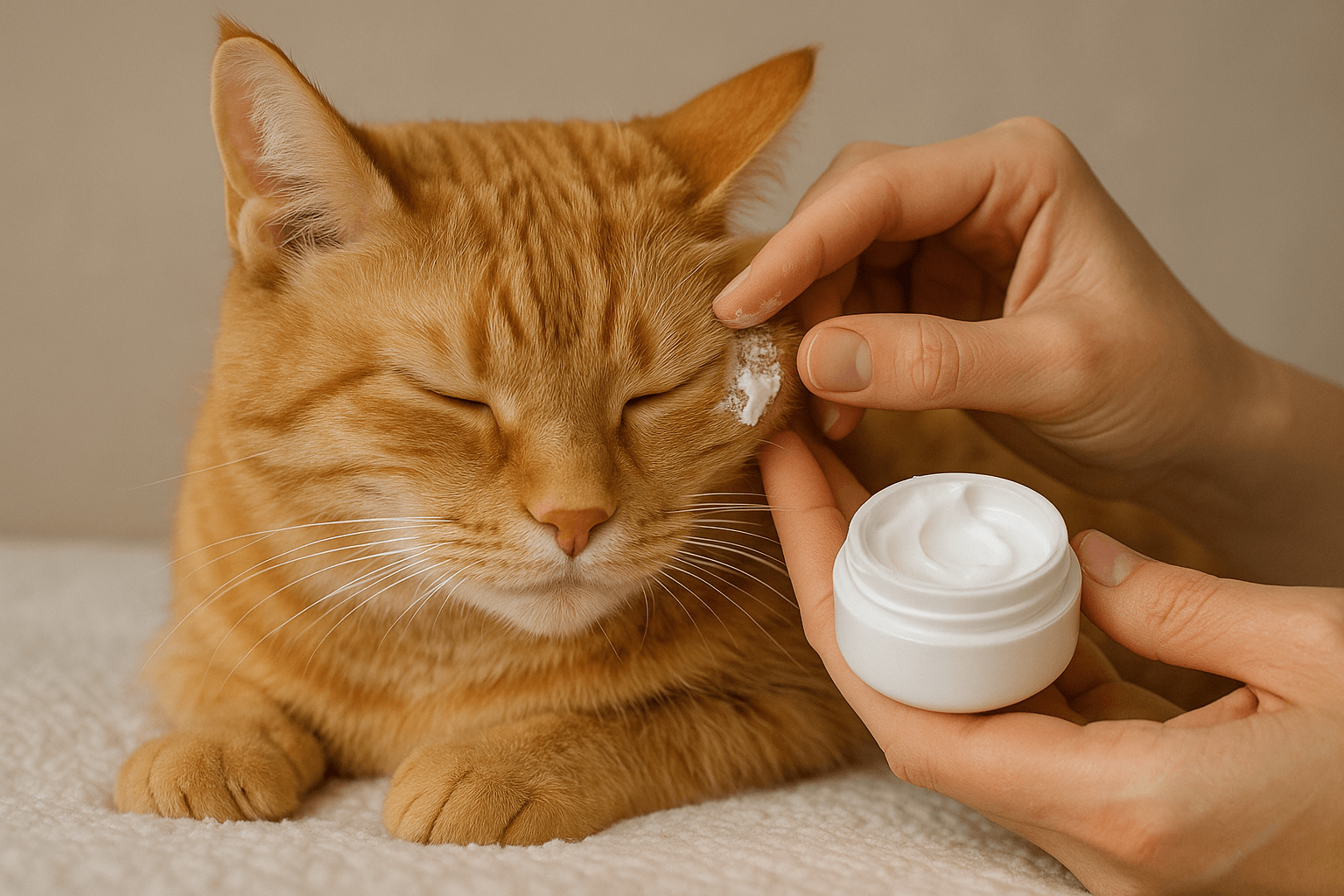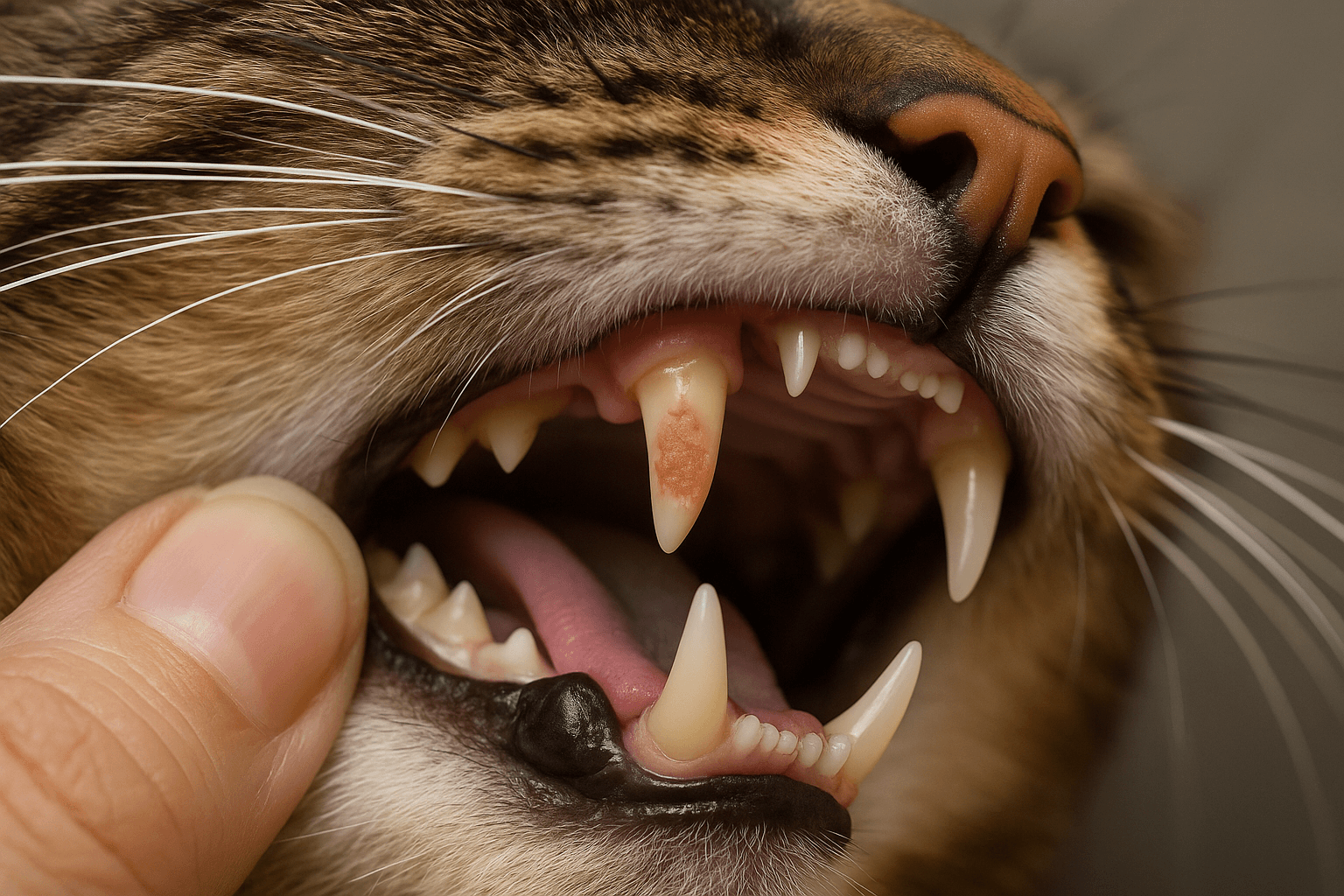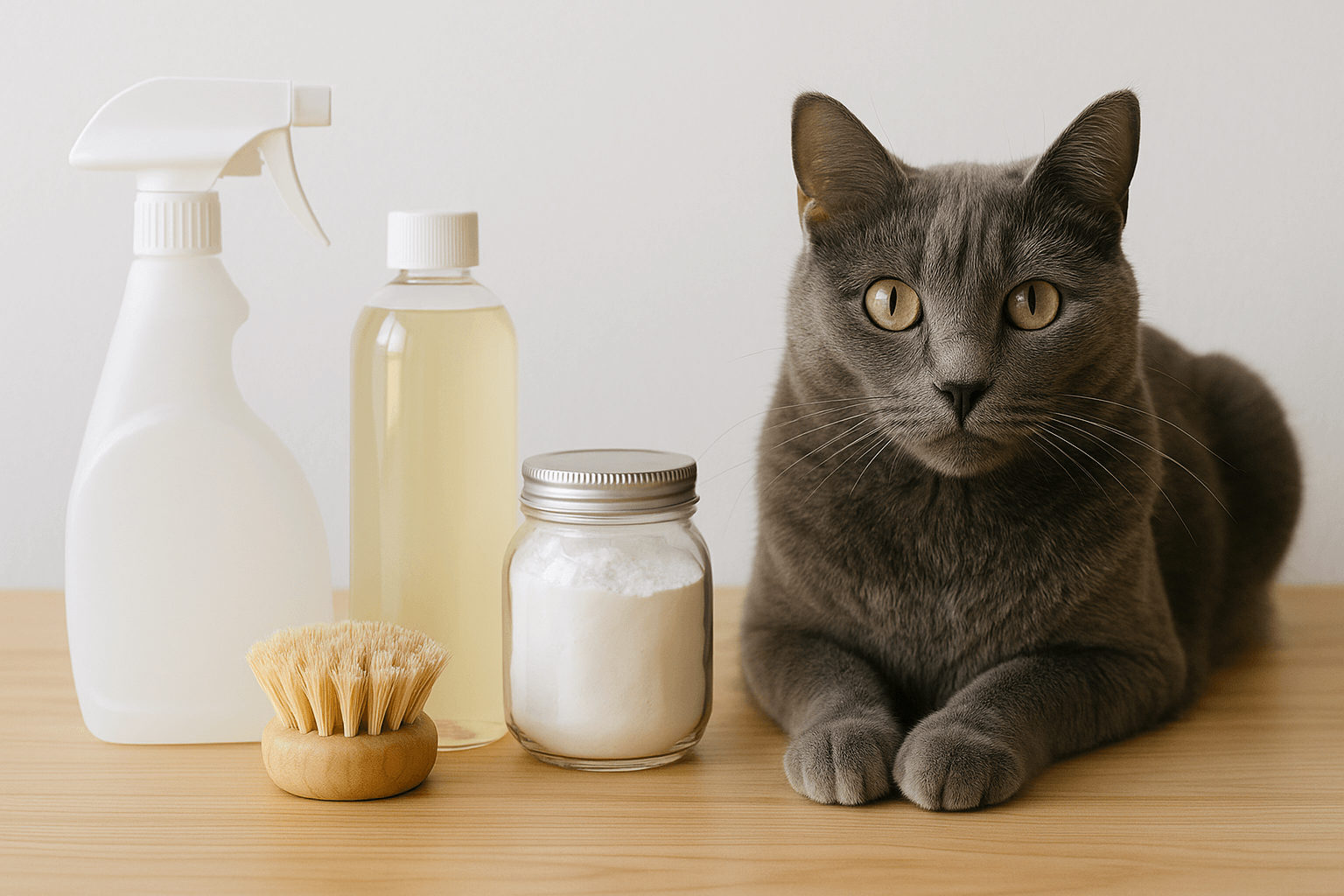Understanding Pre-Diabetic Cats: A Guide for Pet Owners
When it comes to our feline companions, their health is always a top priority. One condition that has been gaining attention among cat owners and veterinarians alike is prediabetes in cats. Prediabetes refers to a state where a cat’s blood sugar levels are higher than normal but not yet high enough to be classified as diabetes. While this condition can be concerning, early detection and proactive management can make a significant difference in your cat’s long-term health. In this blog post, we’ll explore the signs, causes, and treatment options for pre-diabetic cats, equipping you with the knowledge to support your furry friend effectively.
Expert Insight on Diabetes Mellitus
“Diabetes mellitus (commonly referred to as diabetes) is a disease of the endocrine system in which the body either doesn’t produce enough insulin or can’t use the insulin it does produce.”
Signs Your Cat May Be Pre-Diabetic
Recognizing the early warning signs of prediabetes is crucial for timely intervention. These symptoms may be subtle, so staying vigilant about your cat’s behavior and physical condition is essential.
Increased Thirst:
If your cat is drinking more water than usual, it could indicate elevated blood sugar levels.Frequent Urination:
Cats with prediabetes often urinate more frequently as their bodies attempt to flush out excess glucose.Weight Gain or Loss:
Sudden changes in weight, whether gain or loss, can signal underlying metabolic issues.Lethargy and Low Energy:
A previously active cat becoming unusually sluggish may be experiencing early signs of insulin resistance.Excessive Hunger:
Despite eating more, a pre-diabetic cat may still feel hungry due to their body’s inability to process glucose efficiently.
By paying attention to these signs, you can catch prediabetes early and work with your vet to manage it effectively.
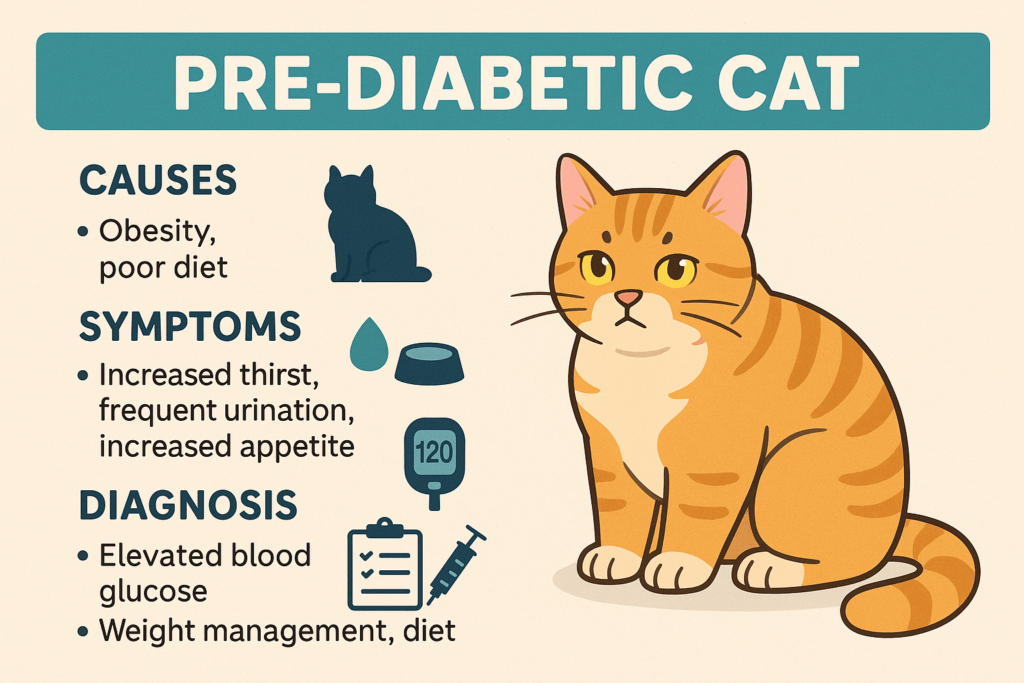
Causes of Prediabetes in Cats
Prediabetes doesn’t develop overnight—it’s often the result of a combination of factors that affect a cat’s metabolism. Understanding these causes can help you take preventive measures.
Obesity:
Excess body fat contributes to insulin resistance, making obesity one of the leading risk factors for prediabetes.Sedentary Lifestyle:
Cats that lack regular exercise are more prone to weight gain and metabolic disorders.Poor Diet Choices:
High-carbohydrate diets can strain a cat’s system, increasing the likelihood of developing prediabetes.Age and Genetics:
Older cats and those with a family history of diabetes are at higher risk of developing prediabetic conditions.Chronic Stress:
Prolonged stress can disrupt hormonal balance, potentially contributing to insulin resistance.
Addressing these root causes can significantly reduce the risk of your cat progressing from prediabetes to full-blown diabetes.
Check this guide 👉Diabetic Cat Vomiting: Best 7 Health Tips!
Check this guide 👉Understanding the Cost of Cat Diabetes Treatment: Best 7 Tips
Check this guide 👉What is Dangerously High Blood Sugar for a Cat? Best 7 Tips!
Preventive Measures for Prediabetes | Warning Signs to Watch For |
|---|---|
Maintain a healthy weight | Increased thirst and urination |
Provide a low-carb, high-protein diet | Sudden weight changes |
Encourage daily exercise | Lethargy and low energy |
Schedule regular vet check-ups | Excessive hunger despite eating |
Minimize stress in the environment | Unexplained vomiting or diarrhea |
Managing Prediabetes Through Diet and Lifestyle Changes
Diet and lifestyle play a pivotal role in managing prediabetes and preventing its progression. Here are some practical steps to keep your cat healthy and happy.
Switch to a Low-Carb Diet:
Opt for high-protein, low-carbohydrate foods that mimic a cat’s natural carnivorous diet.Control Portion Sizes:
Overfeeding can lead to weight gain, so measure portions carefully to avoid overeating.Encourage Physical Activity:
Use toys, interactive play, or even leash training to keep your cat active and engaged.Monitor Weight Regularly:
Keep track of your cat’s weight to ensure they stay within a healthy range.Provide Mental Stimulation:
Enrich your cat’s environment with climbing structures, puzzles, or hiding spots to reduce stress.
These strategies not only manage prediabetes but also enhance your cat’s overall well-being.
Working with Your Veterinarian for a Diagnosis
If you suspect your cat may be pre-diabetic, consulting your veterinarian is the first step toward confirmation and treatment. Here’s what you need to know about the diagnostic process.
Blood Tests:
Your vet will likely perform blood tests to measure glucose levels and assess insulin function.Urine Analysis:
Checking for glucose or ketones in the urine can provide additional insights into your cat’s condition.Physical Examination:
A thorough physical exam helps identify other potential health issues that could contribute to prediabetes.Monitoring Over Time:
Repeated testing may be necessary to confirm whether your cat’s blood sugar levels are consistently elevated.Developing a Treatment Plan:
Based on the diagnosis, your vet will recommend dietary changes, medications, or lifestyle adjustments tailored to your cat’s needs.
Partnering with your vet ensures your cat receives the best care possible.
Common Misconceptions About Prediabetes in Cats
Misunderstandings about prediabetes can lead to confusion and missed opportunities for prevention. Let’s debunk some common myths to set the record straight.
Myth: Only Older Cats Develop Prediabetes:
While age is a factor, younger cats can also develop prediabetes due to poor diet or obesity.Myth: Prediabetes Always Leads to Diabetes:
With proper intervention, many cats can reverse prediabetes before it progresses.Myth: Cats Don’t Need Exercise:
Even indoor cats benefit from regular activity to maintain a healthy metabolism.Myth: Dry Food Is Always Bad:
Not all dry food is high in carbs; some brands offer low-carb, high-protein options suitable for cats.Myth: Prediabetes Is Untreatable:
Early diagnosis and lifestyle changes can significantly improve outcomes for pre-diabetic cats.
Dispelling these misconceptions empowers you to take informed action for your cat’s health.
Foods to Avoid for Pre-Diabetic Cats
Certain foods can exacerbate prediabetes and should be avoided to protect your cat’s health. Steering clear of these items supports better blood sugar control.
High-Carb Kibble:
Many commercial dry foods contain excessive carbohydrates that can spike blood sugar levels.Human Snacks:
Foods like bread, chips, or sweets are unhealthy for cats and can worsen insulin resistance.Milk and Dairy Products:
Despite popular belief, most cats are lactose intolerant, and dairy can upset their digestive system.Processed Treats:
Store-bought treats often contain fillers and sugars that are unsuitable for pre-diabetic cats.Table Scraps:
Feeding scraps from your plate can introduce harmful ingredients and unbalanced nutrition.
Avoiding these foods ensures your cat’s diet remains safe and supportive of their condition.
Emotional Support for Cats with Prediabetes
Caring for a pre-diabetic cat isn’t just about physical health—it’s also about providing emotional support during this transition. A calm and loving environment can make a big difference.
Create a Stress-Free Zone:
Designate a quiet space where your cat can retreat when feeling overwhelmed.Stick to a Routine:
Consistency in feeding, playtime, and sleep schedules reassures your cat and reduces anxiety.Offer Positive Reinforcement:
Reward good behavior with praise or treats to build trust and confidence.Limit Environmental Changes:
Sudden disruptions, such as moving furniture or introducing new pets, can stress your cat unnecessarily.Spend Quality Time Together:
Bonding through gentle petting or play strengthens your relationship and boosts your cat’s mood.
Emotional well-being complements physical health, ensuring your cat feels loved and supported throughout their journey.
Frequently Asked Questions About Pre-Diabetic Cats
What is prediabetes in cats?
Prediabetes occurs when a cat’s blood sugar levels are higher than normal but not yet high enough to diagnose diabetes.
Can prediabetes be reversed?
With proper management, many cats can return to normal blood sugar levels and avoid developing diabetes.
How often should I test my cat’s blood sugar?
Consult your vet for a testing schedule based on your cat’s specific needs and condition.
Is prediabetes common in cats?
While exact numbers vary, prediabetes is increasingly recognized as a precursor to feline diabetes.
What happens if prediabetes goes untreated?
Untreated prediabetes can progress to diabetes, requiring lifelong insulin therapy and stricter management.
Empowering Your Cat’s Health Journey
Prediabetes in cats may sound daunting, but with early detection and proactive care, it’s entirely manageable. By understanding the signs, addressing the causes, and implementing a balanced diet and active lifestyle, you can give your cat the best chance at a long, healthy life. Remember, you’re not alone—your veterinarian is a valuable partner in navigating this journey. Together, you can ensure your feline friend thrives, free from the complications of diabetes.
Cat Dry Skin Treatment: Best 7 Expert Tips! Discover effective remedies and expert advice to soothe your cat’s dry skin, restore their coat’s shine, and ensure lasting comfort with simple, actionable solutions.
Understanding Cat Tooth Resorption: Best 7 Expert Tips! Discover causes, symptoms, and treatment options to protect your cat’s dental health and ensure a pain-free life.
Cerebellar Hypoplasia in Cats: Best 7 Expert Tips! Discover expert advice on caring for cats with cerebellar hypoplasia, managing symptoms, and creating a safe, loving environment for your wobbly feline friend.
Cat-Safe Cleaning Products: Best 7 Expert Tips! Discover safe, non-toxic cleaning solutions to protect your cat’s health while keeping your home spotless and fresh.

